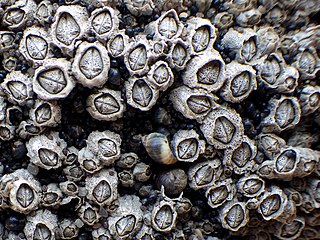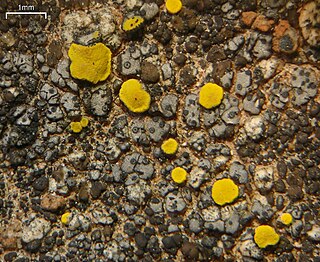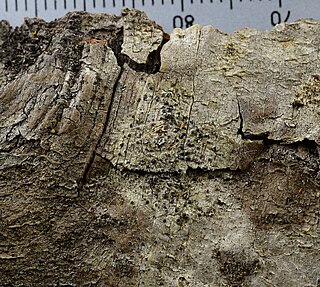
Collemopsidium is a genus of fungi in the family Xanthopyreniaceae. Some members of this genus are marine species, and described as "borderline lichens" or "algicolous" fungi.
Pyrenocollema elegans is a lichen-forming fungus species that grows in marine environments along rocky coastlines. First recognised in 1937 and formally described by the Swedish lichenologist Rolf Santesson in 1992, it is distinguished by its dark brown thallus that forms rosettes up to 10 mm in diameter bearing characteristic black ridges and warts. The species inhabits the intertidal zone, particularly on siliceous rocks, where it commonly associates with barnacles and other marine lichens. It has a wide geographic distribution, occurring along the Atlantic coast of Europe from Norway to northern Spain, and along the Pacific coasts of North and South America. Originally classified under Arthopyrenia, it was later transferred to Pyrenocollema.

Candelaria pacifica is a widely distributed corticolous (bark-dwelling), leprose lichen. It was formally described as a species in 2011.
Verrucaria ahtii is a species of saxicolous (rock-dwelling) crustose lichen in the family Verrucariaceae. It is found in Finland, Lithuania, Russia, and Switzerland, where it occurs on calcareous pebbles.

Heteroplacidium compactum is a species of areolate, crustose lichen in the family Verrucariaceae. It has a cosmopolitan distribution. It is a lichenicolous lichen, growing as a facultative parasite on other lichens, typically on non-calcareous rock. It has rod-shaped (bacilliform) conidia measuring 5–7 μm long, and ascospores that are 11–18 by 8–10 μm. Heteroplacidium zamenhofianum is a closely related species distinguished by having perithecia situated in the algal layer, and smaller ascospores with a more narrow ellipsoid shape.

Verrucaria bernaicensis is a species of saxicolous (rock-dwelling), crustose lichen in the family Verrucariaceae. It was first formally described by Alexandre François Malbranche in 1869. It has a dull, pale grey thallus that is areolate to somewhat squamulose in form. Its perithecia are immersed in the substrata, measure 0.2–0.3 mm in diameter, and lack an involucrellum. Its ascospores are broadly ellipsoid to roughly spherical, measuring 9–11 by 7–9 μm. The lichen has been recorded from Asia, a few European countries, Russia and the Caucasus, and southwestern North America.
Trimmatothele is a genus of saxicolous (rock-dwelling), crustose lichens in the family Verrucariaceae. It has five species. The genus was formally published by lichenologist Alexander Zahlbruckner in 1903. The type species, Trimmatothele perquisita, was originally collected from Norway by Johannes M. Norman, who placed it in the genus Coniothele in 1868. Diagnostic characteristics of Trimmatothele include a thin thallus with a smooth surface; small perithecia that are partially immersed in the substrata and have an involucrellum; asci that contain multiple ascospores; and small, simple ascospores. Trimmatothele has been described as one of the most poorly known genera of lichens due to the rarity of its species, the few available herbarium specimens, and some missing type specimens.
Splanchnonema lichenisatum is a species of corticolous (bark-dwelling) lichen in the family Pleomassariaceae. Found in Korea, it was formally described as a new species in 2014 by Dutch lichenologist André Aptroot and Korean lichenologist Kwang-Hee Moon. The type specimen was collected by the first author from Mount Juwang at an altitude of about 350 m (1,150 ft); there, it was found growing on the bark of an ash tree.
Verrucaria simplex is a species of saxicolous (rock-dwelling), crustose lichen in the family Verrucariaceae. Found in Europe and Asia, it was described as new to science in 1988 by lichenologist Patrick McCarthy. The type specimen was collected by Brian Coppins from Morpeth, Northumberland; there, it was found growing on a fragment of mortar-cement lying on the floor of a woodland. The lichen was later reported from the Czech Republic, and Korea.
Lichenoverruculina is a fungal genus in the family Hyponectriaceae and order Amphisphaeriales. This is a monotypic genus, containing the single species Lichenoverruculina sigmatospora. which was published in Herzogia vol.24 (2) on page 274 in 2011.
Usnea leana is a species of fruticose lichen in the family Parmeliaceae. Found in the Galápagos Islands, it characterized by its pendulous thallus, branches covered with point-like pseudocyphellae, and the presence of galbinic acid. This lichen is currently known to be endemic to the Galápagos, with only two known localities representing its distribution.

Verrucaria viridula is a common and widely distributed species of saxicolous (rock-dwelling), crustose lichen in the family Verrucariaceae. Although it is a somewhat morphologically variable species, two persistent distinguishing characteristics are its relatively large perithecia, which are often curved into a beak, and its large ascospores.
Protothelenella is a genus of fungi in the family Protothelenellaceae. It contains 11 species, some of which form lichens. Protothelenella species have a crustose thallus with spherical to pear-shaped, dark brown to blackish perithecia. Microscopic characteristics of the genus include bitunicate asci with an amyloid tholus, and ascospores that are colourless and contain multiple internal partitions. Some species grow on acidic substrates including rocks, soil, bryophytes, plant detritus or rotten wood. Other species are lichenicolous (lichen-dwelling), growing on species of Solorina, Peltigera, Pseudocyphellaria, or Cladonia.
Siphulopsis is a single-species fungal genus in the family Icmadophilaceae. This monotypic genus the contains the fruticose lichen species Siphulopsis queenslandica, found in Australia. This lichen was originally described by Gintaras Kantvilas in 2018. He tentatively classified it in the genus Knightiella due to morphological similarities with Knightiella eucalypti, but molecular phylogenetics revealed it to constitute a distinct lineage.

Acrocordia cavata is a species of corticolous (bark-dwelling), crustose lichen in the family Monoblastiaceae. It was first formally described in 1814 by the Swedish lichenologist Erik Acharius, who classified it in the genus Verrucaria. The taxon was later proposed for inclusion in the genera Sphaeria, Amphisphaeria, and Arthopyrenia. Richard Harris reclassified it in the genus Acrocordia in 1974.
Flabelloporina is a fungal genus in the family Porinaceae. It consists of a single species, Flabelloporina squamulifera, which grows on tree bark in tropical rainforests. The lichen was first discovered in Costa Rica in 2013 and later found in Brazil, suggesting it may be more widespread in South and Central American wet forests. Flabelloporina is distinguished by its unique thallus structure, which produces numerous small, fan-shaped outgrowths called squamules. These structures, along with its black fruiting bodies and internal features, set it apart from related lichens. Originally classified in the genus Porina, genetic analysis in 2018 revealed it to be distinct, leading to the creation of the new genus Flabelloporina. The lichen typically inhabits the lower levels of humid forests, where it can sometimes extensively cover individual tree trunks.

Verrucaria cavernarum is a species of saxicolous (rock-dwelling) crustose lichen in the family Verrucariaceae. It is found in Finland.

Verrucaria difficilis is a species of saxicolous (rock-dwelling) crustose lichen in the family Verrucariaceae. It is found in Finland.

Phylloporis is a genus of lichen-forming fungi in the family Strigulaceae. It comprises seven species that are primarily found growing on leaves, with occasional occurrences on bark or on rocks.
Puiggariella is a genus of lichen-forming fungi in the family Strigulaceae. It comprises four species of tropical leaf-dwelling lichens.









